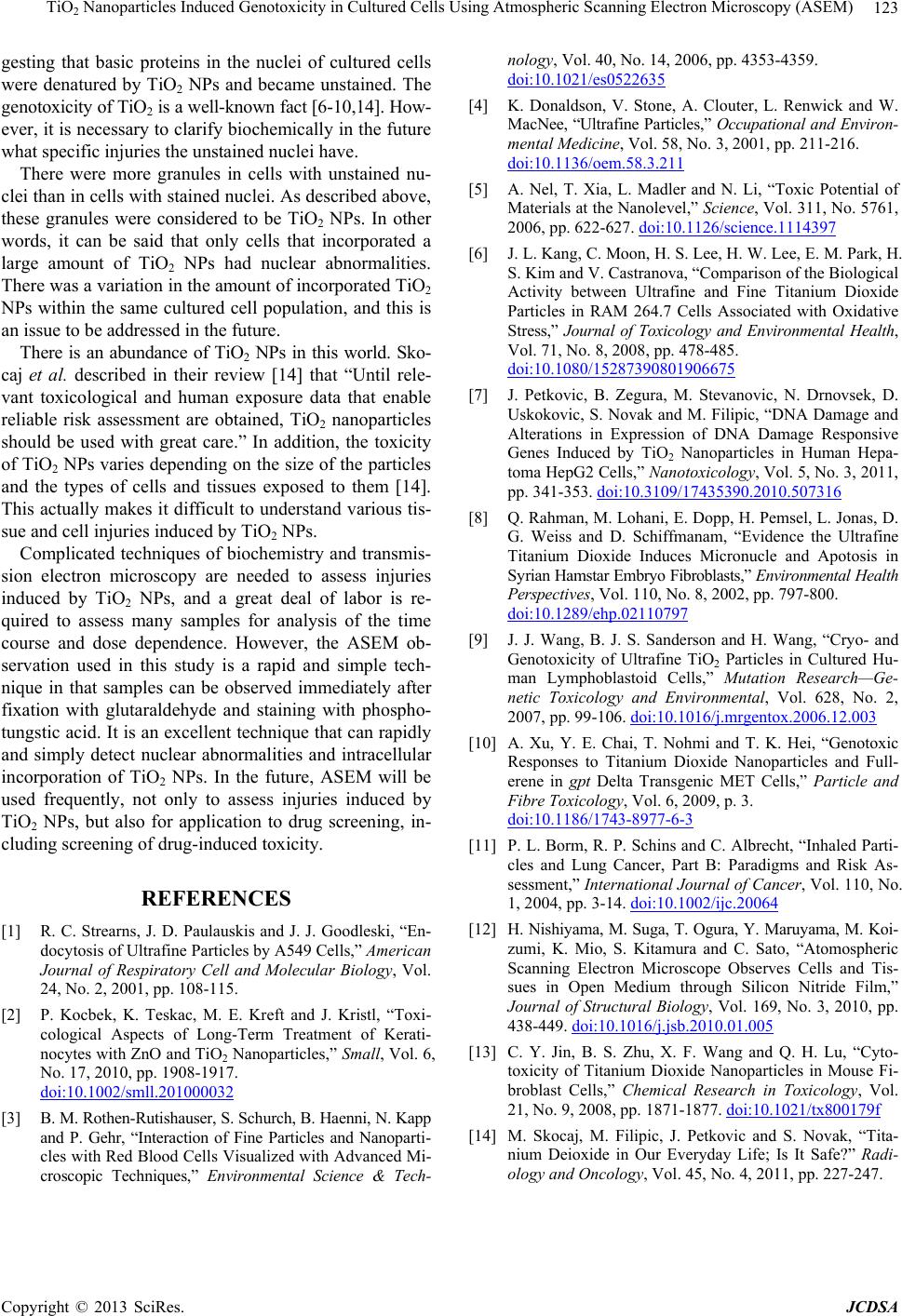
TiO2 Nanoparticles Induced Genotoxicity in Cultured Cells Using Atmospheric Scanning Electron Microscopy (ASEM)
Copyright © 2013 SciRes. JCDSA
123
gesting that basic proteins in the nuclei of cultured cells
were denatured by TiO2 NPs and became unstained. The
genotoxicity of TiO2 is a well-known fact [6-10,14]. How-
ever, it is necessary to clarify biochemically in the future
what specific injuries the unstained nuclei have.
There were more granules in cells with unstained nu-
clei than in cells with stained nuclei. As described above,
these granules were considered to be TiO2 NPs. In other
words, it can be said that only cells that incorporated a
large amount of TiO2 NPs had nuclear abnormalities.
There was a variation in the amount of incorporated TiO2
NPs within the same cultured cell population, and this is
an issue to be addressed in the future.
There is an abundance of TiO2 NPs in this world. Sko-
caj et al. described in their review [14] that “Until rele-
vant toxicological and human exposure data that enable
reliable risk assessment are obtained, TiO2 nanoparticles
should be used with great care.” In addition, the toxicity
of TiO2 NPs varies depending on the size of the particles
and the types of cells and tissues exposed to them [14].
This actually makes it difficult to understand various tis-
sue and cell injuries induced by TiO2 NPs.
Complicated techniques of biochemistry and transmis-
sion electron microscopy are needed to assess injuries
induced by TiO2 NPs, and a great deal of labor is re-
quired to assess many samples for analysis of the time
course and dose dependence. However, the ASEM ob-
servation used in this study is a rapid and simple tech-
nique in that samples can be observed immediately after
fixation with glutaraldehyde and staining with phospho-
tungstic acid. It is an excellent technique that can rapidly
and simply detect nuclear abnormalities and intracellular
incorporation of TiO2 NPs. In the future, ASEM will be
used frequently, not only to assess injuries induced by
TiO2 NPs, but also for application to drug screening, in-
cluding screening of drug-induced toxicity.
REFERENCES
[1] R. C. Strearns, J. D. Paulauskis and J. J. Goodleski, “En-
docytosis of Ultrafine Particles by A549 Cells,” American
Journal of Respiratory Cell and Molecular Biology, Vol.
24, No. 2, 2001, pp. 108-115.
[2] P. Kocbek, K. Teskac, M. E. Kreft and J. Kristl, “Toxi-
cological Aspects of Long-Term Treatment of Kerati-
nocytes with ZnO and TiO2 Nanoparticles,” Small, Vol. 6,
No. 17, 2010, pp. 1908-1917.
doi:10.1002/smll.201000032
[3] B. M. Rothen-Rutishauser, S. Schurch, B. Haenni, N. Kapp
and P. Gehr, “Interaction of Fine Particles and Nanoparti-
cles with Red Blood Cells Visualized with Advanced Mi-
croscopic Techniques,” Environmental Science & Tech-
nology, Vol. 40, No. 14, 2006, pp. 4353-4359.
doi:10.1021/es0522635
[4] K. Donaldson, V. Stone, A. Clouter, L. Renwick and W.
MacNee, “Ultrafine Particles,” Occupational and Environ-
mental Medicine, Vol. 58, No. 3, 2001, pp. 211-216.
doi:10.1136/oem.58.3.211
[5] A. Nel, T. Xia, L. Madler and N. Li, “Toxic Potential of
Materials at the Nanolevel,” Science, Vol. 311, No. 5761,
2006, pp. 622-627. doi:10.1126/science.1114397
[6] J. L. Kang, C. Moon, H. S. Lee, H. W. Lee, E. M. Park, H.
S. Kim and V. Castranova, “Comparison of the Biological
Activity between Ultrafine and Fine Titanium Dioxide
Particles in RAM 264.7 Cells Associated with Oxidative
Stress,” Journal of Toxicology and Environmental Health,
Vol. 71, No. 8, 2008, pp. 478-485.
doi:10.1080/15287390801906675
[7] J. Petkovic, B. Zegura, M. Stevanovic, N. Drnovsek, D.
Uskokovic, S. Novak and M. Filipic, “DNA Damage and
Alterations in Expression of DNA Damage Responsive
Genes Induced by TiO2 Nanoparticles in Human Hepa-
toma HepG2 Cells,” Nanotoxicology, Vol. 5, No. 3, 2011,
pp. 341-353. doi:10.3109/17435390.2010.507316
[8] Q. Rahman, M. Lohani, E. Dopp, H. Pemsel, L. Jonas, D.
G. Weiss and D. Schiffmanam, “Evidence the Ultrafine
Titanium Dioxide Induces Micronucle and Apotosis in
Syrian Hamstar Embryo Fibroblasts,” Environmental Health
Perspectives, Vol. 110, No. 8, 2002, pp. 797-800.
doi:10.1289/ehp.02110797
[9] J. J. Wang, B. J. S. Sanderson and H. Wang, “Cryo- and
Genotoxicity of Ultrafine TiO2 Particles in Cultured Hu-
man Lymphoblastoid Cells,” Mutation Research—Ge-
netic Toxicology and Environmental, Vol. 628, No. 2,
2007, pp. 99-106. doi:10.1016/j.mrgentox.2006.12.003
[10] A. Xu, Y. E. Chai, T. Nohmi and T. K. Hei, “Genotoxic
Responses to Titanium Dioxide Nanoparticles and Full-
erene in gpt Delta Transgenic MET Cells,” Particle and
Fibre Toxicology, Vol. 6, 2009, p. 3.
doi:10.1186/1743-8977-6-3
[11] P. L. Borm, R. P. Schins and C. Albrecht, “Inhaled Parti-
cles and Lung Cancer, Part B: Paradigms and Risk As-
sessment,” International Journal of Cancer, Vol. 110, No.
1, 2004, pp. 3-14. doi:10.1002/ijc.20064
[12] H. Nishiyama, M. Suga, T. Ogura, Y. Maruyama, M. Koi-
zumi, K. Mio, S. Kitamura and C. Sato, “Atomospheric
Scanning Electron Microscope Observes Cells and Tis-
sues in Open Medium through Silicon Nitride Film,”
Journal of Structural Biology, Vol. 169, No. 3, 2010, pp.
438-449. doi:10.1016/j.jsb.2010.01.005
[13] C. Y. Jin, B. S. Zhu, X. F. Wang and Q. H. Lu, “Cyto-
toxicity of Titanium Dioxide Nanoparticles in Mouse Fi-
broblast Cells,” Chemical Research in Toxicology, Vol.
21, No. 9, 2008, pp. 1871-1877. doi:10.1021/tx800179f
[14] M. Skocaj, M. Filipic, J. Petkovic and S. Novak, “Tita-
nium Deioxide in Our Everyday Life; Is It Safe?” Radi-
ology and Oncology, Vol. 45, No. 4, 2011, pp. 227-247.